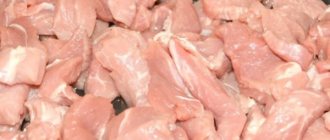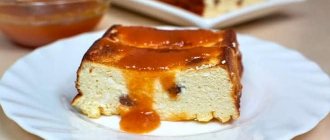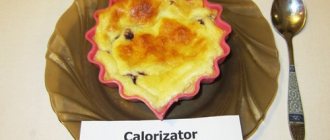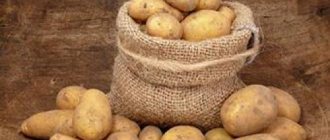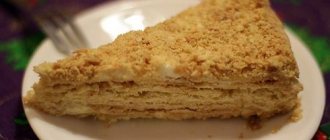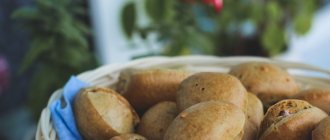Calories Cornstarch. Chemical composition and nutritional value.
Nutritional value and chemical composition of “Corn starch”.
| Nutrient | Quantity | Norm** | % of the norm in 100 g | % of the norm in 100 kcal | 100% normal |
| Calorie content | 343 kcal | 1684 kcal | 20.4% | 5.9% | 491 g |
| Squirrels | 1 g | 76 g | 1.3% | 0.4% | 7600 g |
| Fats | 0.6 g | 56 g | 1.1% | 0.3% | 9333 g |
| Carbohydrates | 83.5 g | 219 g | 38.1% | 11.1% | 262 g |
| Alimentary fiber | 1.7 g | 20 g | 8.5% | 2.5% | 1176 g |
| Water | 13 g | 2273 g | 0.6% | 0.2% | 17485 g |
| Ash | 0.2 g | ||||
| Vitamins | |||||
| Vitamin B4, choline | 0.4 mg | 500 mg | 0.1% | 125000 g | |
| Macronutrients | |||||
| Potassium, K | 15 mg | 2500 mg | 0.6% | 0.2% | 16667 g |
| Calcium, Ca | 17 mg | 1000 mg | 1.7% | 0.5% | 5882 g |
| Magnesium, Mg | 1 mg | 400 mg | 0.3% | 0.1% | 40000 g |
| Sodium, Na | 30 mg | 1300 mg | 2.3% | 0.7% | 4333 g |
| Sera, S | 2.6 mg | 1000 mg | 0.3% | 0.1% | 38462 g |
| Phosphorus, Ph | 20 mg | 800 mg | 2.5% | 0.7% | 4000 g |
| Microelements | |||||
| Iron, Fe | 0.47 mg | 18 mg | 2.6% | 0.8% | 3830 g |
| Manganese, Mn | 0.053 mg | 2 mg | 2.7% | 0.8% | 3774 g |
| Copper, Cu | 50 mcg | 1000 mcg | 5% | 1.5% | 2000 g |
| Selenium, Se | 2.8 mcg | 55 mcg | 5.1% | 1.5% | 1964 |
| Zinc, Zn | 0.06 mg | 12 mg | 0.5% | 0.1% | 20000 g |
| Digestible carbohydrates | |||||
| Starch and dextrins | 83.5 g | ||||
| Saturated fatty acids | |||||
| Saturated fatty acids | 0.1 g | max 18.7 g | |||
| Polyunsaturated fatty acids | |||||
| Omega-6 fatty acids | 0.025 g | from 4.7 to 16.8 g | 0.5% | 0.1% |
The energy value of corn starch is 343 kcal.
Main source: Skurikhin I.M. and others. Chemical composition of food products. Read more.
** This table shows the average levels of vitamins and minerals for an adult. If you want to know the norms taking into account your gender, age and other factors, then use the “My Healthy Diet” application.
Product calorie analysis
Ratio of proteins, fats and carbohydrates:
- home
- Product composition
- Composition of cereals, flour, pasta
- Chemical composition of “Corn starch”
Tags:
Corn starch calorie content 343 kcal, chemical composition, nutritional value, vitamins, minerals, what is useful Corn starch, calories, nutrients, beneficial properties Corn starch
Energy value, or calorie content
- this is the amount of energy released in the human body from food during the digestion process. The energy value of the product is measured in kilocalories (kcal) or kilojoules (kJ) per 100 grams. product. The kilocalorie used to measure the energy value of food is also called a food calorie, so when caloric content is reported in (kilo)calories, the prefix kilo is often omitted. You can see detailed energy value tables for Russian products here.
The nutritional value
— content of carbohydrates, fats and proteins in the product.
Beneficial features
Corn starch contains a record amount of vitamin PP, as well as vitamins B and E, and natural minerals (sodium, fluorine, calcium, potassium, magnesium). The rich natural composition provides a wide range of beneficial properties:
- removal of waste and toxins from the body;
- nutrition of nerve cells;
- supporting active growth of muscle tissue cells;
- does not contain gluten, used for preparing dietary baked goods;
- normalizes blood clotting;
- stabilizes the general condition during depression and stress;
- promotes the treatment of diseases of the urinary, cardiovascular (hypertension, anemia), nervous system (epilepsy);
- has choleretic properties;
- strengthens the immune system;
- reduces blood cholesterol levels;
- increases appetite.
In home cosmetology and folk medicine, corn starch is the main ingredient in anti-inflammatory compounds, powders, ointments, masks, face and body creams.
What are the benefits of corn starch?
General benefit
Despite the fact that the product practically does not contain a large number of microelements and vitamins, it can be beneficial. Useful qualities of starch:
- Helps activate the process of removing toxins and harmful substances that get there when consuming various products and through the environment.
- Activates the growth of muscle tissue.
- Increases the level of blood clotting, which is useful for people suffering from such abnormalities.
- Provides nutrition to nerve tissue cells.
- Stabilizes and reduces the amount of sugar in the blood.
- It has a positive effect on the nervous system, allowing a person to calm down and relax.
- Has an anti-inflammatory effect, activates the process of bile excretion.
- Activates the body's defenses due to the content of B vitamins.
Among other things, corn starch is used in folk medicine as a component for the preparation of products aimed at preventing hypertension and cystitis.
For women
Starch made from corn grains can bring invaluable benefits to the female body. It is used in cosmetology to restore the beauty of hair and facial skin. With its help, it is possible to return the skin to its natural color, remove wrinkles, restore hair structure, give it shine and elasticity.
For men
For the male body, according to experts, corn starch can also be beneficial. First of all, it has a positive effect on the musculoskeletal system and muscle tissue, as it contains calcium and magnesium. They are the main components of muscles and bones.
According to experts, men are more susceptible to cardiovascular diseases. Starch contains all the necessary microelements that are required for the proper functioning of the heart muscle and blood vessels.
During pregnancy
Many scientists suggest that thanks to corn starch, the period of toxicosis is tolerated much better. The microelements included in the composition help cope with unpleasant symptoms and replenish the supply of elements that are necessary to maintain the functioning of the myocardium and blood vessels.
But starch made from corn grains is a difficult product to digest. That is why during pregnancy it is recommended to reduce the consumption of foods with a large amount of starch.
Video:
how to eat properly during pregnancy Expand
When breastfeeding
During lactation, it is important for a woman to eat properly and monitor her diet. This is due to the fact that all microelements, harmful substances, and vitamins entering the body also enter milk in a certain amount.
Experts recommend reducing the amount of foods that contain cornstarch when breastfeeding. It is difficult to digest. It is best to give preference to natural corn.
For children
Starch, obtained from corn grain, is one of the main components from which various cereals, mixtures and jelly are made.
It can be introduced into the diet starting from three months. An allergic reaction to this product occurs in rare cases. It is expressed in the appearance of a rash, itching, and redness on the skin. If symptoms appear, you should avoid eating foods that contain corn starch and consult a doctor.
The nutritional value
| Indicator name | Nutrient content per 100 grams of product |
| Calorie content, kcal | 343 |
| Proteins, g | 1 |
| Fats, g | 0.6 |
| Carbohydrates, g | 83.5 |
| Vitamin PP (niacin equivalent), mg | 0.166 |
| Potassium, mg | 15 |
| Calcium, mg | 17 |
| Magnesium, mg | 1 |
| Sodium, mg | 30 |
| Dietary fiber, g | 1.7 |
| Phosphorus, mg | 20 |
Data on the nutritional value of the product are presented for informational purposes; the actual calorie content and nutritional value of the product may differ depending on the manufacturer and supplier (30% in one direction or the other). Please take this into account when planning your diet.
What is the calorie content of starch per 100 grams?
Starch has the appearance of a white powder, sometimes with a grayish tint, odorless and tasteless. It belongs to the polysaccharides. It is obtained from various crops, such as potatoes, corn, rice, wheat, and beans. If you look at starch under a microscope, you can see that it consists of small grains, and if you rub it between your fingers, it will make a squeaking sound. This sound means that the grains are rubbing against each other. They also do not dissolve in cold water.
Types of starch
As stated earlier, starch is made from a variety of plants. Let's look at their most famous types.
The most popular and frequently used is potato starch. It is made by crushing potatoes and then washing them, after which sulfur dioxide is added to give it a whiter color. After boiling, peeling, then drying. It also contains vitamins and minerals: sodium, calcium, potassium. Starch has very beneficial properties, a coating effect in the stomach and helps remove excess fluid from the body. The calorie content of potato starch is approximately 314 kcal per hundred grams of powder.
Corn starch, like potato starch, is beneficial for the body. It is slightly different in color - white with a yellowish tint. To make it, corn is soaked in sulfurous acid to dissolve the protein that binds starch. It is then crushed, washed and dried.
Corn starch consists mainly of complex carbohydrates, which is not contraindicated for people with diabetes - its consumption does not increase blood sugar levels. Useful for all internal organs. Corn starch has a much higher calorie content, approximately 343 kcal per hundred grams of product.
If we compare two types of starch, namely for what purposes they are used in a dish, then potato starch will thicken faster and the liquid will be transparent, while corn starch will make the consistency more viscous and cloudy.
The calorie content of starch is very high, so its consumption is not recommended for people on a diet.
If the dry, tasteless powder is diluted with water, it will create a sticky paste. After entering the human body, starch is converted into glucose, which is so necessary for energy. Therefore, it is advisable to consume it little by little. You don't have to eat jelly every day; starch is found in many foods, such as pasta and cereals.
Regardless of the calorie content of starch, it is still a very important product in the human diet. It is used for making jelly, various pies, thickening sauces and much more.
Use of corn starch in folk medicine
Most products that are used exclusively in cooking can actually be used in folk medicine to treat certain diseases and injuries. Cholecystitis, inflammation of the gallbladder, bedsores, burns, bruises are just some of the few conditions for which starch helps.
For cholecystitis
Starch has a healing, anti-inflammatory and enveloping effect. Thanks to these properties, the product is used in the treatment of cholecystitis. However, this method cannot be independent; it only supports and accelerates drug treatment.
Using the product for medicinal purposes does not require effort, time or money. The patient needs to stir half a teaspoon of starch in half a glass of warm, clean water and drink three times a day before meals for 21 days.
For inflammation of the gallbladder
Starch also relieves inflammation of the gallbladder due to its anti-inflammatory properties. Before use, you should consult a specialist and find out whether it can be combined with medications.
The patient needs to mix 30 grams of starch in 300 milliliters of water. The solution is taken 10 grams three times a day. After 7-10 days, application is completed.
From high blood pressure
Corn starch has a positive effect on the cardiovascular system. Helps normalize high blood pressure. For treatment, dilute 200 grams of powder in 100 milliliters of water. The liquid is drunk at one time. The duration of treatment is two weeks.
For bedsores
It has an anti-inflammatory and healing effect on bedsores. It is possible to correct the problem with its help even in advanced conditions when a wound has appeared. For this purpose, not only corn, but also potato products are used. They sprinkle the wound twice a day in a thick layer. Before each procedure, the affected area is treated with an antiseptic wipe.
Ointment for burns
The product quickly relieves redness and pain from burns. It helps even those who are severely sunburned. To do this, it is mixed with water in such a ratio that a paste is obtained, even more like an ointment. Apply to the burn site for 2 hours.
Recommended reading: Benefits of butter
Compress for bruises
It often happens that a bruise appears completely unnoticed in a very inappropriate place. And it needs to be removed as soon as possible. In this case, pharmaceutical drugs are not always available. Starch will help remove the problem. Take a few tablespoons of the product and mix with a spoonful of warm water. The remedy for bruises is ready! They apply it to the necessary areas every three hours.
Usage
But it is used not only in cooking, but also in cosmetology, medicine and pharmacology. In medicine, it is part of many medicines; it is also used in the manufacture of powders. In cosmetology, it is added to creams, since the calorie content of starch is high, it nourishes and moisturizes the skin very well. For people with stomach diseases, doctors recommend consuming starch in the form of jelly.
Methods of application
Starch made from corn has both benefits and harms for the body. Its positive qualities have ensured its widespread use in various fields.
Starch is mainly used in cooking. It is used as a thickener in the preparation of sauces, jelly, puddings, mousses, sweets and various fillings.
It works a little worse than potato powder, but better than wheat flour. Such qualities have led to its frequent use in the meat and dairy, confectionery and baking industries. Its presence in ready-made dishes is not noticeable at all; it does not spoil their taste or add turbidity.
Starch is found in some vitamin supplements. It is added to them instead of sugars. This substance breaks down for quite a long time, so it does not provoke a sharp jump in sugar levels in the body. This quality is especially important for people suffering from diabetes and cardiovascular diseases.
Corn powder is actively used in cosmetology. You can use it to prepare an effective mask for oily skin, which will reduce the work of the sebaceous glands, cleanse and tighten pores.
This recipe is especially popular: you need to mix corn starch, zinc oxide and spirulina in equal proportions. And if you add violet or sweet clover powder to this composition, you will get an effective product for moisturizing and nourishing the skin.
There are other home remedies that combat the signs of aging, reduce wrinkles and improve your appearance.
Due to its absorbent properties, it is used to make powders, talcs and natural deodorants. These cosmetics are great for caring for delicate baby skin.
If necessary, you can make dry shampoo from starch, which will come to the rescue when the water in the house is turned off. To prepare it you will need:
- 26 g corn powder;
- 75 g baking soda;
- 2 g lavender essential oil.
All ingredients are mixed until a homogeneous consistency is obtained. The composition is applied along the entire length of the hair. The root zone should be massaged especially carefully. Now you just need to comb your hair. They will be completely clean, because the soda and starch will absorb all the excess sebum.
Types of corn starch:
Corn starch can be regular or modified. Modified corn starch is starch that has been processed in a special way during production in order to provide any other properties necessary for the preparation of any culinary products and for better digestibility by the human body. This is not a genetically modified product, it is made from natural corn, and it is safe.
Modified corn starches are full-fledged corn starches that differ from regular ones in some modified property, for example, modified starch may be odorless, have a different color, and not swell in water. The properties of modified starch can be effectively used in the preparation of various culinary products.
Daily intake of corn starch
Most products bring great benefits to the body, but whatever it is, there is always a measure of consumption. An adult should consume 300-400 grams of starch per day. It is not recommended to eat a lot of carbohydrate dishes (pasta, porridge, rolls) in one day and at the same time reach the norm. The result is an excess of carbohydrates, which in some diseases cause a lot of harm.
Benefits of corn starch:
In small quantities, corn starch is beneficial to the human body, its benefits include nutritional properties that provide energy to the body's cells and help build muscle tissue. The benefit of corn starch also lies in the fact that starch is a supplier of carbohydrates to the human body, which are vital for the normal functioning of all organs.
Thanks to enzymes, starch is broken down into water and carbon dioxide, during which energy is released that contributes to the functioning of a living organism.
Is it possible to replace corn starch with potato starch?
It is not recommended to replace corn starch with potato starch, since potato starch gives a much greater degree of thickening to confectionery products, as a result of which they turn out to be very thick, not as tender and soft as planned according to the recipe.
On the other hand, potato starch cannot be replaced with corn starch when preparing jelly, since the degree of thickening of corn starch is not sufficient to obtain a thick jelly. Corn starch and potato starch are starches with different properties and cannot be substituted.
Is it possible to use corn starch for weight loss?
In most cases, nutritionists do not reject cornstarch. Moreover, they are advised to replace potato for the first time and consume it until they manage to exclude baked goods from the diet. But you need to be careful with the product. Still, it contains a large amount of carbohydrates, and the calorie content does not inspire confidence. And eating bread, sweets and starch will bring a couple of extra pounds.
Recommended reading: What are the benefits of rye bread?
The famous author of the diet, Pierre Dukan, allows it to be used already in the second stage with 20 grams per day.


